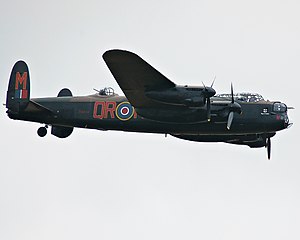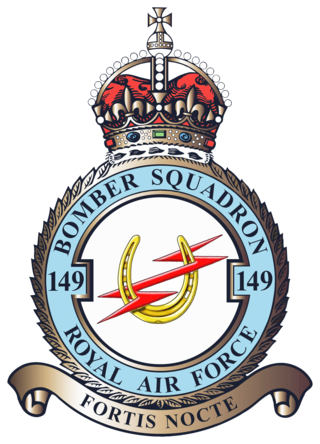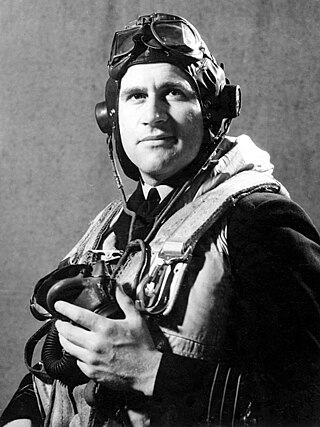| List of Avro Lancaster operators | |
|---|---|
 |
The following are operators of the Avro Lancaster:
| List of Avro Lancaster operators | |
|---|---|
 |
The following are operators of the Avro Lancaster:
From May 1948 to August 1949 the Argentine Air Force received 15 Lancasters (registered B-031 to B-045) previously operated by RAF. [1]
Soviets were able to repair two of six Avro Lancasters which made forced landings near Yagodnik airfield, near Arkhangelsk during attacks on the German battleship Tirpitz. Both ex-617 Squadron Avro Lancasters were operated briefly as transports and long range reconnaissance aircraft before being retired due to lack of spare parts. [5]

The Avro Lancaster is a British Second World War heavy bomber. It was designed and manufactured by Avro as a contemporary of the Handley Page Halifax, both bombers having been developed to the same specification, as well as the Short Stirling, all three aircraft being four-engined heavy bombers adopted by the Royal Air Force (RAF) during the same wartime era.

The Avro 679 Manchester was a British twin-engine heavy bomber developed and manufactured by the Avro aircraft company in the United Kingdom. While not being built in great numbers, it was the forerunner of the famed and vastly more successful four-engined Avro Lancaster, which was one of the most capable strategic bombers of the Second World War.

Royal Air Force Waddington otherwise known as RAF Waddington is a Royal Air Force (RAF) station located beside the village of Waddington, 4.2 miles (6.8 km) south of Lincoln, Lincolnshire in England.

The Avro Type 694 Lincoln is a British four-engined heavy bomber, which first flew on 9 June 1944. Developed from the Avro Lancaster, the first Lincoln variants were initially known as the Lancaster IV and V; these were renamed Lincoln I and II. It was the last piston-engined bomber operated by the Royal Air Force (RAF).

The Avro Anson is a British twin-engined, multi-role aircraft built by the aircraft manufacturer Avro. Large numbers of the type served in a variety of roles for the Royal Air Force (RAF), Fleet Air Arm (FAA), Royal Canadian Air Force (RCAF) and numerous other air forces before, during, and after the Second World War.

The Avro York was a British transport aircraft developed by Avro during the Second World War. The design was derived from the Avro Lancaster heavy bomber, several sections of the York and Lancaster being identical. Due to the importance of Lancaster production, York output proceeded slowly until 1944, after which a higher priority was placed upon transport aircraft.

The Avro 691 Lancastrian was a Canadian and British passenger and mail transport aircraft of the 1940s and 1950s developed from the Avro Lancaster heavy bomber. The Lancaster was named after Lancaster, Lancashire.

No. 460 Squadron is a Royal Australian Air Force intelligence unit active within the Defence Imagery and Geospatial Organisation (DIGO). It was first formed as a heavy bomber squadron during World War II on 15 November 1941 and disbanded on 10 October 1945 after seeing extensive combat over Europe. The squadron was a multinational unit, but most personnel were Australian. No. 460 Squadron was reformed on 2 July 2010 and is currently located in Canberra.

Royal Air Force Syerston, commonly known as merely RAF Syerston, is a Royal Air Force station in the parish of Flintham, near Newark, Nottinghamshire, England. Opened in 1940, it was used by the Royal Air Force (RAF) as a bomber base during the Second World War, operating Vickers Wellingtons, Avro Manchesters, and the Avro Lancaster heavy bombers. Post-war, it became home to Jet Provosts of the 2 Flying Training School. It is now home to the Royal Air Force Central Gliding School.

No. 149 Squadron RAF was a Royal Air Force Squadron between 1918 and 1956. Formed 1918 in the Royal Flying Corps as a night-bomber unit, it remained in that role for the rest of its existence which spanned three periods between 1918 and 1956.

No. 1 Group of the Royal Air Force is one of the two operations groups in RAF Air Command. Today, the group is referred to as the Air Combat Group, as it controls the RAF's combat fast-jet aircraft and has airfields in the UK, as well as RAF Support Unit Goose Bay in Canada. The group headquarters is located alongside Headquarters Air Command at RAF High Wycombe, Buckinghamshire. The other operational group is No. 2 Group RAF.
Royal Air Force Foulsham, more commonly known as RAF Foulsham is a former Royal Air Force station, a military airfield, located 15 miles North-West of Norwich, in the English county of Norfolk, East Anglia, from 1942 to 1945.

No. 459 Squadron RAAF was a Royal Australian Air Force squadron that operated during World War II. It was formed in early 1942 and served as a maritime patrol and bomber unit in the Mediterranean theatre until early 1945, operating mainly Lockheed Hudson aircraft. In early 1945, the squadron was transferred to the United Kingdom with the intention of being transferred to RAF Coastal Command and converting to Vickers Wellington bombers; however, due to a series of delays the conversion was not completed and the squadron was disbanded in April 1945.

No. 463 Squadron RAAF was a Royal Australian Air Force heavy bomber squadron during World War II. The squadron was formed in the United Kingdom in late 1943 from personnel and aircraft allocated from No. 467 Squadron RAAF. The squadron was equipped with Avro Lancaster bombers and flew its first raids on Germany immediately after being formed. Operating as part of RAF Bomber Command No. 463 Squadron conducted raids against cities, industrial facilities and military targets in Germany, France and Norway throughout 1944 and until the end of the war in May 1945. Following the war, the squadron evacuated Allied prisoners of war from Europe until it was disbanded in late 1945.

No. 467 Squadron RAAF was a Royal Australian Air Force bomber squadron, active over North West Europe during World War II. Formed in November 1942 as an Article XV Squadron in Britain, the squadron was notionally an Australian squadron under the command of the Royal Air Force, and consisted of a mixture of personnel from various Commonwealth nations. After becoming operational in early 1943, the squadron flew operations in Occupied Europe until the end of the war flying Avro Lancaster heavy bombers. It was scheduled to deploy to the Far East to take part in further operations against Japan, but the war ended before it could complete its training and the squadron was disbanded in September 1945.
No. 236 Operational Conversion Unit was a Royal Air Force Operational Conversion Unit which was active between 1947 and 1992 and formed by re-numbering and merging different units.
Royal Air Force Skellingthorpe or more simply RAF Skellingthorpe is a former Royal Air Force station which was operational during the Second World War. It was located just west of the city of Lincoln, England about 2.5 miles (4 km) south-east of the village of Skellingthorpe on a field previously called Black Moor. After its closure the site was developed as the Birchwood estate.

No. 576 Squadron RAF was a Royal Air Force Second World War heavy bomber squadron.

William Lloyd Brill, & Bar was a senior officer and bomber pilot in the Royal Australian Air Force (RAAF). Born in the Riverina district of New South Wales, he was a farmer and a member of the Militia before joining the RAAF in 1940. After training in Australia and Canada, he was posted to Britain in 1941 to take part in the air war over Europe. Brill first saw combat with No. 460 Squadron RAAF, flying Vickers Wellington medium bombers. He was awarded the Distinguished Flying Cross (DFC) in May 1942 for attacking a target after his plane was badly damaged by anti-aircraft fire. Following assignment as an instructor with the Royal Air Force (RAF), he returned to the bombing campaign in January 1944 as a flight commander with No. 463 Squadron RAAF, flying Avro Lancaster heavy bombers.